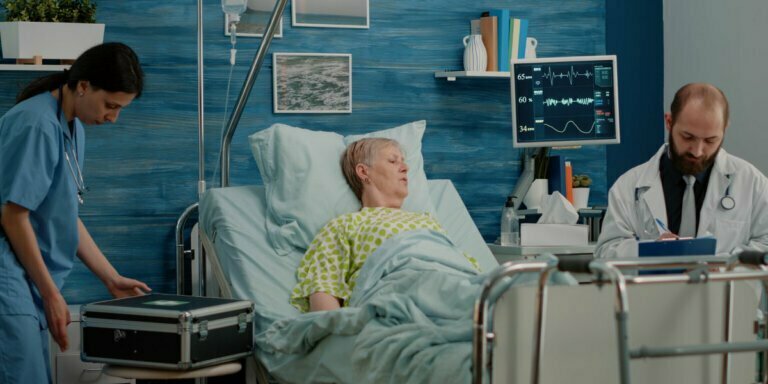Medicare-approved Remote Patient Monitoring (RPM) has become an increasingly important aspect of healthcare delivery. RPM allows healthcare providers to collect and monitor patient data remotely using electronic devices such as biometric sensors and mobile applications. Remote monitoring through telehealth services has enabled healthcare providers to provide more efficient and effective care to patients, especially those enrolled in Medicare and Medicaid Services.
The Centers for Medicare & Medicaid Services (CMS) have issued guidelines for the reimbursement of RPM services, requiring that these services be furnished under the general supervision of a physician and that the physician be available to provide assistance and direction throughout the course of the RPM services. Additionally, the CMS has established guidelines for the appropriate use of monitoring systems and the proper billing for RPM services. It’s important for healthcare providers to understand and comply with these guidelines to maximize reimbursement for the RPM services they provide to their patients.
This guide will teach healthcare providers about Medicare reimbursement for RPM services. We’ll discuss the benefits of using RPM, and review how Medicare pays for these services. We’ll also provide tips on how to maximize reimbursement for your organization.
Medicare Remote Patient Monitoring Use
Medicare covers RPM services when provided to beneficiaries who meet certain criteria. The services must be medically necessary, and the patient must be provided with the necessary education and training on using the monitoring device. The RPM program must be supervised by a healthcare provider. RPM services provided to Medicare beneficiaries include the provision of monitoring devices, patient education and training, and care management services.
To be eligible for Medicare RPM reimbursement services, healthcare providers must use specific Current Procedural Technology (CPT) codes for remote patient monitoring and care management services. These codes allow healthcare providers to bill for the remote physiologic monitoring services and the care management services that are provided to the patient. Medicare reimbursement rates for RPM services are determined by the Centers for Medicare and Medicaid Services (CMS) and may vary based on the specific codes used.
Understanding Medicare Reimbursement for Remote Patient Monitoring
Medicare has recently begun to cover certain RPM services, but it is important to note that not all RPM services are covered. Healthcare providers should check with Medicare to determine which services are covered and which are not.
CPT codes for billing RPM services: 99457 and 99458
To bill Medicare for RPM services, healthcare providers must use specific CPT codes designated for RPM, including 99457 and 99458. These codes are used for billing for the remote evaluation of physiologic data, such as blood pressure, heart rate, and glucose levels, obtained by the patient and reported to the physician or clinician.
Coverage requirements for RPM services
To be eligible for reimbursement, RPM services must be furnished to a patient who is enrolled in the Medicare program, and the services must be medically necessary. Additionally, the RPM services must be furnished under the general supervision of a physician, and the physician must be available to provide assistance and direction throughout the course of the RPM services.
Role of the supervising physician in billing for RPM services
The physician who supervises the RPM services is responsible for ensuring that they are medically necessary, and that they meet all the coverage requirements. The physician must also certify that the RPM services were furnished, and that the patient is under his or her care.
Supervision of the billing process for RPM services
It’s important for supervising physicians to thoroughly understand the billing process for RPM services. The billing process includes the use of appropriate CPT codes and the accurate recording of services provided. This will help ensure that the billing process is done correctly and that the provider gets the reimbursement to which they are entitled.
Devices and Services Qualified for Medicare Purposes
A. Types of monitoring devices that qualify for Medicare
For a device to qualify for reimbursement under Medicare, it must be FDA-approved, and must be used for the purpose of collecting physiologic data that is related to the patient’s diagnosis. Common devices include biometric sensors such as blood pressure cuffs and glucose meters, mobile applications, and other electronic devices that collect and transmit data to the healthcare provider.
B. Continuous Glucose Monitoring Devices
Continuous glucose monitoring devices (CGM) are used to measure glucose levels in real-time, allowing healthcare providers to track changes in glucose levels over a prolonged period. CGMs are becoming more common as reimbursement qualified devices under certain conditions and specific patient population.
C. Self-measured blood pressure monitoring devices
Self-measured blood pressure monitoring devices, also known as home blood pressure monitors, allow patients to take their own blood pressure readings at home and transmit the data to their healthcare provider. These devices can provide valuable information to healthcare providers and, when properly used, may be qualified for reimbursement under certain conditions.
D. Other devices that can be used for RPM services
In addition to the above-mentioned devices, other devices — such as pulse oximeters, weight scales, and activity trackers — can also be used for RPM services.
E. Services that qualify for Medicare reimbursement
In order for RPM services to be reimbursed by Medicare, they must be furnished to a patient who is enrolled in the Medicare program, and they must be medically necessary. The services must be furnished under the general supervision of a physician, and the physician must be available to provide assistance and direction throughout the course of the RPM services.
F. Remote physiologic monitoring treatment management services
Remote physiologic monitoring treatment management services involve the collection and interpretation of physiologic data, such as blood pressure and glucose levels, by a healthcare provider, and the development and implementation of a treatment plan based on that data. These services must meet certain requirements to be qualified for reimbursement.
G. Care management services codes: 99453 and 99454
These codes are used to bill for care management services furnished to a patient, such as the creation of a care plan, communication with the patient, and coordination of services, in conjunction with the RPM service.
H. Patient and caregiver set-up and education on device use
Setting up the device, providing patient education on proper use of the device, and training on how to properly collect and transmit the data is important to ensure the device is used correctly, and that the data collected is accurate and can be used for monitoring and treatment management. This service may also qualify for reimbursement depending on the circumstances.
Strategies for Maximizing Medicare Reimbursement for RPM Services
1.) Importance of proper documentation for Medicare reimbursement
To ensure that RPM services are properly reimbursed by Medicare, healthcare providers must keep accurate and detailed documentation of the services they provide. This includes documenting patient data and the patient’s response to treatment, as well as the use of the appropriate CPT codes.
2.) Communicating with the patient and interactive communication
Regular and interactive communication with patients can be an important component of RPM services and can also help ensure that the services are properly reimbursed. This includes using telehealth or other technologies to communicate with patients and providing patient education on the use of monitoring devices.
3.) Collecting relevant patient history and physiologic data
Healthcare providers must collect relevant patient history and physiologic data to provide effective RPM services. This includes information about the patient’s medical history, current medications, and other relevant information. Collecting accurate data will also ensure that the services are medically necessary and that the services meet the requirements for reimbursement.
4.) Proper use of CPT codes for billing RPM services
To bill Medicare for RPM services, healthcare providers must use the appropriate CPT codes. This includes using CPT codes 99457 and 99458 for remote evaluation of physiologic data, and codes 99453 and 99454 for care management services.
5.) Billing for days of monitoring and management services
Healthcare providers can bill for days of monitoring services, as well as management services, when providing RPM services. This includes the daily review and interpretation of physiologic data, and the development and implementation of a treatment plan based on that data.
6.) Importance of working with coding professionals for proper billing
It’s important to work with coding professionals who are well-versed in the billing requirements for RPM services to ensure that the billing process is done correctly. Such professionals can help to ensure that services are properly reimbursed and to minimize any errors in the billing process.
Maximizing Reimbursement Opportunities with DrKumo’s Remote Patient Monitoring Services
DrKumo is a reputable provider of remote patient monitoring (RPM) technology solutions with a mission to assist healthcare providers (HCPs) in maximizing their reimbursement opportunities. They have a wealth of experience in billing, negotiating with payers, and staying current on the most recent reimbursement policies and regulations. DrKumo’s team of experts possess an in-depth knowledge of reimbursement across various payers, including Medicare and Medicaid. They provide customized advice to ensure healthcare providers can optimize their reimbursement opportunities.
Not only that, but DrKumo is also dedicated to helping healthcare providers maximize the benefits of implementing RPM. They offer data analytics to demonstrate the value of the RPM program to payers, monitor program outcomes and enhance patient outcomes. DrKumo also provides guidance on how to set up the RPM system, manage patient data and comply with payer policies.
Takeaways
By following the steps outlined by DrKumo, healthcare providers can maximize their reimbursement opportunities for RPM services. These include using CPT codes specific to RPM, communicating with patients, collecting patient history and data, and complying with payer policies. It’s essential to work with a reputable provider like DrKumo to help you fully maximize your reimbursement opportunities, and help more of your patients gain more time that RPM affords them to live healthy lives.
Contact DrKumo for expert assistance in navigating RPM reimbursement and enhancing patient outcomes as a healthcare provider.








